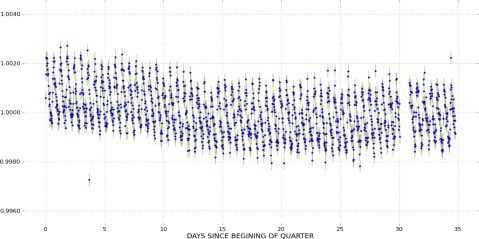A Newly Spotted RR Lyrae Star
Although Kepler was designed to find extrasolar planets, the Kepler light curves with their high temporal cadence and measurement precision is a rich data set for studying stellar astrophysics. Although the main goal of Planet Hunters is to search for new extrasolar planets, the Talk discussion tool was designed to enable volunteers to be able to identify other types of potentially interesting variable stars and oddball light curves that we weren’t necessarily looking for with the main classification interface.
With so many eyes looking through the light curves for 160,000 stars on the website, we’re bound to find an interesting star or two, and we have. Planet Hunters has helped discover a new RR Lyrae variable star. This is the second one spotted by Planet Hunters. Just like the first (which was spotted a year ago), this one was spotted by the keen eyes of our volunteers on Talk. It was reported to the Science Team, and Chris contacted the Kepler folks who study these sorts of thing, and it looks like it is indeed a new find. Congratulations to all involved. The RR Lyrae discovery is actually not the Kepler target star, but is nearby and contributing light into the photometric aperture, contaminating the actual Kepler star’s light curve with it’s changing brightness.
RR Lyrae’s are a special type of variable star. The radial pulsations cause the star to expand and contract producing observed changes in the star’s luminosity and subsequently the observed light curve. The American Association of Variable Star Observers (AAVSO) has a nice writeup describing the history and properties of RR Lyraes. Because the pulsations are supposedly simple radial expansion, these stars are often used as standard candles for measuring distances. But there is still a lot to learn about these stars. In particular, the underlying cause of Blazhko modulation, a periodic amplitude and/or phase variation of the pulsations with a period of typically 10-100x the typical pulsation period, that some of the RR Lyraes undergo is still an open question in stellar astrophysics.
This class of variable stars is named for the prototype star, RR Lyrae, first identified to exhibit these oscillations and observed patterns of variation. The original RR Lyrae just so happens to be in the Kepler field as KIC 7198959. There are currently about 40 known RR Lyrae stars in the Kepler field, so this is indeed a rare find. This new find will subsequently be studied by the Kepler Cepheid & RR Lyrae Working Group, and hopefully eventually be included in publication featuring all RR Lyrae stars identified in the Kepler field.
6 responses to “A Newly Spotted RR Lyrae Star”
Trackbacks / Pingbacks
- - October 15, 2013
- - January 4, 2014


Reblogged this on Spherical Chickens in a Vacuum.
Hi Meg! As long as i’m looking the above light curve, a thought is saying to me: “WHY NOT” this gap be a candidate planet in this RR LYRAE star. As i know there is no one astrophysical reason that this kind of stars towards their end of their lives have not any planets.
Meg i’m looking fwd for comments by you. Thanks.
I’m not an expert on RR Lyraes or variable stars, so I don’t know if there is a specific reason why these stars couldn’t potentially host planets. If the gap you are referring to is the one in the light curve above. The gap is too big to be from a planet, also the planet will never completely block out the light of the star, since it is much smaller and should only block a portion of the star’s light. The gap is due to Kepler not observing likely it was pointed back at Earth (and not at the Kepler field) so that the data collected could be downloaded to Earth.
Cheers,
~Meg
Yes Meg. Taking in my mind your comments (Fm 18/10/2013) i notice a reducing of “pulsating” light curve in 13th to 14th day (horizontal axis) where maybe there is something